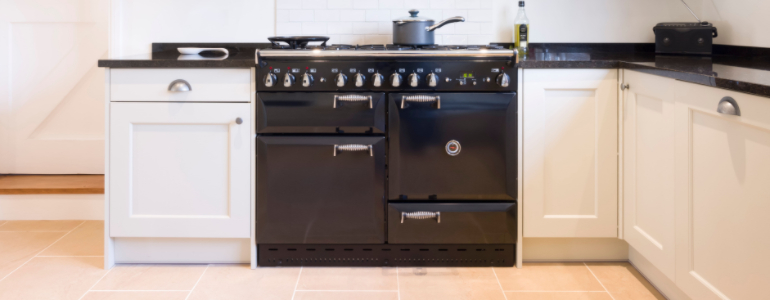
Aga and Rayburn are the cooking appliances that bring heart, warmth and comfort into a home. These two ranges have many similarities but they also have notable differences. Appreciating these differences will be important if you’re considering installing a range and want to know which will best suit your needs.
So, if you
- Are thinking about replacing your cooking appliance with a new one;
- Wonder what is the difference between AGA and Rayburn cookers;
- Want to know if an AGA cooker is a better option than Rayburn.
Then this post is for you!
Table of Contents
What is an AGA range cooker?
An AGA is a heat storage stove. It’s made of cast iron so stores and transmits heat efficiently. Although originally designed to use solid fuel, modern AGAs run on gas, electricity or oil.
AGAs are designed to be always on and have hotplates and multiple ovens which are automatically controlled by a thermostat. Different ovens are set to different temperatures which means that the cook can prepare a variety of dishes simultaneously.
What is a Rayburn cooker?
Like AGAs, Rayburns are cast iron heat storage ranges, that also have the capacity to heat water. Some Rayburns will also run radiators, in the case of the largest models, up to 20 of them.
You can buy Rayburns that run on gas, electricity or oil and also models suitable for use with wood, briquettes or coal.
What is the difference between an AGA and a Rayburn cooker?
One major difference is that a Rayburn can be used as an all-in-one appliance, a cooker, a hot water boiler and to run central heating too. If saving space is an issue Rayburn may be more suited to your needs. A Rayburn also offers multiple solid fuel options, something that may be essential if you live in a remote area and don’t have access to gas or are subject to regular electricity outages.
Other differences between AGA and Rayburn
AGA cookers don’t have hot water or central heating capacity but they offer far more extensive cooking options. Your choice of models will dictate which of these things you’ll benefit from. These options are explained in more detail below:
AGA
- A Heat storage cooker which is ‘always on’, with heat production controlled by a thermostat.
- The separate ovens have different preset temperatures, you put the food in the oven suited to the dish being prepared.
- Two round hotplates, one for boiling, one for simmering.
- Available in natural or bottled gas, electricity or oil-fueled models.
2-oven AGA
- A hot top oven for roasting or baking.
- A lower cooler oven for slow cooking or simmering.
- The two ovens are approximately the same size.
3-oven AGA
- Hot roasting oven on the top right.
- Moderate oven for baking on the lower right.
- Cooler bottom oven for simmering and slow cooking.
- The 3 ovens are of a similar size.
4-oven AGA
- Top right-hand side hot oven for roasting.
- Bottom right-hand side moderate oven for baking.
- Top left-hand side simmering oven.
- Bottom left-hand side warming oven.
- All ovens are a similar size.
- A choice of warming plate or two-burner gas hotplate.
Rayburn
- Semi-heat storage stove.
- Choice of cooking only, cooking and hot water or cooking, hot water and central heating.
- Some models offer a choice of continuous or intermittent burning.
- A top main oven can be varied in temperature.
- A smaller lower oven used for warming.
- One rectangular graduated hot plate, the temperature of this can be adjusted.
- Different sized models are available but Rayburns are typically smaller than AGAs (and less expensive).
Similarities between AGA and Rayburn
There are a few features shared by AGA and Rayburn, most of which are the very things that make them enduringly popular choices.
- Cast iron construction.
- Vitreous enamel finish with a wide choice of colours.
- High initial cost when compared to conventional cookers.
- Long life expectancy (if well-maintained an Aga or Rayburn can last for decades).
- Environmentally friendly (cast iron cookers can be repaired and new ones may be constructed from recycled metal).
- Classic design (fashions come and go but an AGA or Rayburn range will never look dated or tired).
AGA and Rayburn cookers vs conventional oven
Still undecided on whether you need an AGA or Rayburn or should opt for a more conventional cooking appliance? Both options have pros and cons of course:
AGA and Rayburn pros
- An AGA range allows you to cook different dishes requiring different temperatures at the same time.
- Both ranges will act as a heat source for your kitchen as well as a cooker.
- Choose a Rayburn and you can opt for a model that will also provide your hot water and run your central heating.
- Rayburn ranges are available in solid fuel models.
- Radiant heat cooking is more even and locks in flavours without drying out the food.
AGA and Rayburn cons
- High initial purchase cost.
- Because AGAs are designed to run constantly you may need a second cooker for summer use or your kitchen will overheat.
- Cooking in a range can be challenging for a novice (though once the art is acquired most people say they’d never go back).
- If you don’t do a lot of cooking a range may be more than you need.
- Range cookers are bulky and may not be suitable for a small kitchen.
Pros and cons of conventional and built-in ovens
Most people don’t choose range cookers. Why might that be and what are they missing out on?
Conventional and build-in oven pros
- You can choose an oven size that suits your kitchen.
- Easier to manage for a novice cook, most recipes are based on cooking times in conventional ovens.
- A built-in oven may look better in a modern, streamlined kitchen.
- Conventional cookers can be set at any height, which saves a lot of stooping and bending.
- Some conventional cookers offer modern extras such as steam or microwave ovens.
- Modern tech features are available, Wi-Fi or touchscreen control for instance.
Conventional and build-in oven cons
- Limited cooking space, you can really only prepare one or two dishes at a time.
- It can be hard to bake evenly in a conventional oven.
- You may need to buy extra appliances to do everything that a range cooker will do.
Takeaways
So, there we have it, your thorough guide for the difference between AGA and Rayburn range cookers. A few key things to remember are:
- AGA or Rayburn ranges are generally suitable for people with larger kitchens.
- AGA ranges are most appealing to people who are serious about cooking and want to prepare lots of dishes simultaneously.
- Rayburns are less flexible as stoves but offer hot water and central heating capacity.
Need a professional range cooker cleaner?
Enter your postcode to view our rates and availability in your area.
For questions about the services we offer visit our main site
Do you have an AGA or a Rayburn cooker? What’s your experience with it? Let us know in the comment section below, we would love to hear from you!
Image source: Shutterstock / Paul Maguire









Leave a Reply